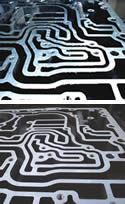A Cool Deburring Technique
Ice blasting is a process that uses ice crystals as impact media to remove contaminants. It is popular in Europe for industrial cleaning work because it uses no detergents, solvents or abrasives.
Secondary operations often are a necessary evil to remove manufacturing blemishes, such as machining burrs and casting flash. Traditionally, techniques such as tumbling, grinding, abrasive blasting and high-pressure water spray have been used to eliminate these flaws. However, some deburring methods can mar or significantly damage part surface finish.
Ice blasting is a process that uses ice crystals as impact media to remove contaminants. It is popular in Europe for industrial cleaning work because it uses no detergents, solvents or abrasives. Universal Ice Blast (Kirkland, Washington) has developed a process based on this environmentally friendly premise that will remove burrs and flash from metal parts without inflicting surface damage. The company's Ice Blast system also takes advantage of the post-impact phase change from ice to water, which serves to scrub and rinse parts in one operation.
The process is most effective on soft materials, such as aluminum and brass. It also can be used to deburr steel and iron, depending on burr size and how strongly the burr is attached to the part. It is particularly useful for cast parts, such as engine blocks, transmission housings, cylinder heads and intake manifolds, because it removes machining burrs and flash in one step.
In practice, ice particles carried in a blast air stream impact the part as solids, displacing burrs, flash or large contaminants upon contact. As the ice particles begin their phase change to water after impact, they deform and slide along the part surface, scrubbing away minute contaminants. Upon completing the phase change, the ice—now water—rinses the part.
The Ice Blast system requires only electrical power, tap water and compressed air. It consumes only 20 to 30 gallons of water per hour during continuous use.
The system generates its own ice using the reliable immersed rotating cold drum method. The ice particles are vacuumed from the drum and delivered through a venturi-effect blast nozzle. The nozzle provides a blast circle that is approximately 3 inches in diameter and can move up to 6 inches per second for a deburring operation. It can be manipulated by hand within a blast cabinet or automatically, using a robot and part transport system.
Most applications require a dryer module to remove water from the part. Even aluminum parts can oxidize if allowed to air dry. For ferrous materials, a rust inhibitor application module can be installed to further prevent oxidation.
For flash removal on castings, high-pressure water spray is commonly used. However, during casting production, the outer surface of the cast part cools quicker than the inside, forming a laminate shell. A 4,000 to 6,000 psig deflashing water spray can penetrate this shell and delaminate the casting, digging up "divots" of material. This leads to costly rework and higher scrap rates.
In contrast, ice blasting is performed at relatively low pressures (115 to 150 psig), so there is no risk of casting delamination.
Related Content
-
Mastercam Software Improves Programming Flexibility
IMTS 2024: Mastercam introduces Mastercam 2025, with features including Mastercam Deburr for automated edge finishing, finish passes, mill-turn support for Y-axis turning and automatic license update notifications.
-
Vollmer Ultrasonic Cleaning, Deburring System Provides Process Reliability
IMTS 2024: The UltraTec Ultrasonic A25 cleans and deburrs small and delicate components, making it well suited for applications in heavily regulated sectors with challenging demands.
-
Tapmatic Showcases Deburring Tool for a Consistent Edge Break
IMTS 2024: Tapmatic Corp. exhibits the DeBurr-Z deburring tool for simplified programming and a consistent edge break.


















